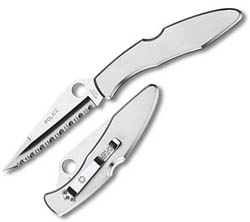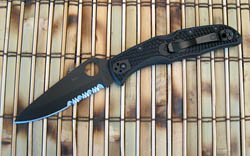[Ed. note – This is part two in a four part police training series on duty knives. Make sure you read Randall’s other articles in the series on his general thoughts about police knives, neck knives and the KA-BAR TDI.]
Let’s talk about folding knives.
I must admit to an infatuation with balisong, or butterfly, knives. For me it is part heritage and part love of toys. I had a three-inch Benchmade Bali-Song that rode in the top right pocket of my BDU shirt when I was in K9.
I could take the balisong out with either hand, but it was secure in the buttoned pocket. I could open the blade with one hand. The knife had the advantage of three pins securing the blade to the handles, which made it superior in strength to a single pivot pin folding knife.

The all-stainless steel balisong was a little heavy for shirt pocket carry, but it did give me many hours of playtime while giving the dog a break during the night shift.
Sal Glesser of Spyderco, Inc. invented their trademarked round opening hole and the knife mounted clothing clip, which were introduced in the Clipit line of knives in 1981. As the Clipits caught on, these industry revolutionizing innovations would later change how most cops wore a knife.
In 1984, Spyderco introduced the Police Model. It had the round opening hole, clothing clip, and stainless steel construction. The blade was 4 1/8”. At 5.5 ozs, the knife was a bit heavy, but its long slim handle made it carry easily in the pocket. The clip point blade, at over 4 inches, was seen by knife combatives instructors to be of the length that can reach vital organs when used to pierce the torso.

Early versions of the Police Model were referred to as P.I.G.s, for “Pride Integrity Guts,” which was stamped into the blades. This knife is still popular and is in current production. Over the years, variations have been made with handles in aluminum, titanium, G-10, and carbon fiber. They have been made with plain, serrated, or part serrated blades of varying stainless steels.
In the early 1980’s, the one-handed opening Spyderco Clipits influenced other knife makers. Previously, cheap switchblades and butterfly knives were the only knives you could easily open with one hand. After the arrival of the blade hole, makers began putting thumb studs on the rear of the blades to circumvent Spyderco’s patent. Spyderco licensed the opening hole to other companies such as Benchmade, Inc. and later Emerson Knives, Inc.
Spyderco did not sit back and rest on the original Clipits’ laurels. The company began producing numerous variations of their knives. A state-of-the-art lightweight folding knife is their Endura4. The current knife is the fourth generation of this design.
The Endura4 is a mid-lock folder with the blade opening hole and clothing clip, but it has improvements Spyderco has worked at for decades. The handles slabs are FRN, or fiberglass reinforced nylon. These slabs have what Spyderco calls “bi-directional texturing” for a sure grip wet or dry. Beneath the FRN are skeletonized stainless steel liners to give the knife rigidity.
The knife blade is advanced VG-10 stainless steel and is flat saber-ground for strength. The blade can be had in a black titanium carbonitride coating to subdue the blade and protect it from corrosion. The knife’s clip can be mounted on any of the four corners for convenience. Because the knife has a reversible clip and is a lock-back, with the unlocking mechanism on the spine, the whole knife is ambidextrous.

I have carried an Endura4, clipped in my non-dominant side pants pocket, for the last year. I carry the knife for both utility and as a back-up weapon in case of a gun-grab. Our department trains officers to lock down your gun with the dominant hand if someone is trying to take your firearm from the holster, then take violent action to prevent it. The non-dominant hand is available for empty-handed strikes or to access another weapon.
I carry the Endura4 in the left front pocket and an Emerson La Griffe knife in the 5.11 boot on my left foot. In a standing position, the pocket knife is accessible. If the fight were to go to the ground, which isn’t my preference, I was taught to roll on to the holstered gun to keep it away from the suspect. This leaves me free to grab either knife, or kick from this ground-fighting position while protecting my head with the arms until I can gain distance.
This is not meant as a tutorial for a gun-grab, only to illustrate my department’s position and my preference for blade carry based upon it. Always follow your department’s S.O.P’s, General Orders, or training when employing any combative techniques.
While the Endura4 has made a home in my pocket, I recently received a test and evaluation knife from another manufacturer. I’ll be moving its pocket clip to the left side of the knife and trying it out on my next shift. I’ll let you know how it works.